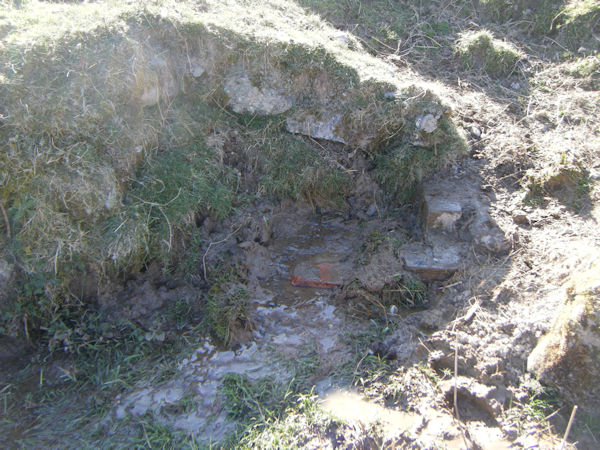 |
Dedication: Saint Gwynnog Location: Llangwm Coordinates: 52.9869, -3.53711 Grid reference: SH969443 Heritage designation: none |
HOME - WALES - DENBIGHSHIRE
 |
Dedication: Saint Gwynnog Location: Llangwm Coordinates: 52.9869, -3.53711 Grid reference: SH969443 Heritage designation: none |
St Gwnnod is certainly the same as St Gwynnog, a 6th century saint who is known to have founded a church at Llanwnnog, a village in Montgomeryshire (about 30 miles from Llangwm), and at Llanwonno, in Glamorgan. Gwynnog, along with his brother Nwython, were sons of the famed St Gildas, a 6th century monk who is reputed to have been the first British historian. Gildas was a great traveller, and he has his own holy well in Brittany, in Saint-Gildas-de-Rhuys, where he founded a monastery, and where his relics, which survived the French Revolution, are still kept. Gwynnog and Nwython themselves seem to have had quite a presence in the area around Llangwm, suggesting that they may have spent a significant amount of time in the vicinity, or at least had a lasting impact on its inhabitants. Although Llangwm's parish church is now dedicated to St Jerome, it was originally under the joint patronage of St Gwynnog and St Nwython, who, presumably, founded it; additionally, two chapels, one dedicated to St Gwynnog, and the other to St Nwython, also existed just under 3 miles from Llangwm in Llangwm Dinmael. Clearly, the medieval cult of these two saints was prevalent in the area, and certainly would have included a holy well or two. It is quite possible that St Nwython may have had his own holy well somewhere in the parish, although there is no record of this.
Nothing is known about the early history of Ffynnon Wnnod, apart from the fact that it almost certainly would have supplied Llangwm's church with baptismal water. It was, however, evidently a local landmark during the late 17th century, as it was mentioned by Edward Lhuyd in 1698, as "Ffynnon Wnnod chw'r m. odhiar yr eglwys", meaning "Ffynon Wnnod, a quarter of a mile beyond the church". By the 20th century, its existence was known of, but it had no particular significance within the parish, and it had become known as "Fron Bach Spring". When the Royal Commission visited the well on the 20th of August, 1912, they called it "Ffynnon Wnnod, St. Gwnnod's Well":
|
This, the sacred well of the village, is believed to be the spring now commonly known as the 'Fron Bach spring,' near Melysfan; and it was stated that the former name [Ffynnon Wnnod] was in use for it within the memory of persons now living. The water flows from the side of a bank in a copious stream, the spring being unprotected except by a couple of flag stones. |
Interestingly, the field in which this well is located is named on a tithe map of 1841 as "Cae yr Ffynnon", or "Field of the Well", which clearly refers to Ffynnon Wnnod. It is also interesting that the well is linked to the church directly by a public footpath; this was almost certainly the route that was taken to carry baptismal water down to the church.
Unfortunately, the well's location has recently become confused with another well, located a few hundred metres to the east, in the grounds of Melysfan, a nearby house. This well was uncovered in the early 1980s by the owner of Melysfan, Patrick Radley, who was searching for an alternative water supply for his house. He was of the opinion that this well, a circular structure eight feet deep, was Ffynnon Wnnod, and does not seem to have been aware of the spring to the west that was described by the Royal Commission; perhaps by this time it was nothing more than a bog oozing water. Radley restored this circular well, and installed a wooden lid, on which was engraved the name "Ffynnon Wnnod". However, this well was certainly not the historical Ffynnon Wnnod, and it has since been discovered that this circular well is filled with ground water, and not by a natural spring, it being a deep well, which holy wells almost never are.
It is worth noting that the Historic Environment Record has seriously confused both wells, and merged them into one record. The Archwilio database simultaneously asserts that the well is "a modern brick built chamber over [a] formerly unprotected spring", whilst stating that "the roughly circular well is lined with rough stone and is covered by slate slabs". The Archwilio database also comes with a photograph of the circular well in the grounds of Melysfan, but gives for the grid reference the location of the real Ffynnon Wnnod, the spring that was described by the Royal Commission.
When I visited the real Ffynnon Wnnod in the April of 2025, it initially appeared to be nothing more than a grassy marsh oozing water. Once I had cleared away some of the mud and grass, parts of a brick structure, perhaps the remains of a small basin, became visible, and a strong trickle of clear water began to issue from it. The site has clearly changed since 1912, although not massively, as the well still sits on the side of a small bank. However, the site has certainly been neglected for some time, and is in dire need of a good clear out.
|
Access: A public footpath runs right beside the well; when I visited the site, this footpath had been deliberately blocked by the farmer with a barbed wire fence. This fence was not impossible to climb, however, and it is worth the effort to reach the well. |
Copyright 2025 britishholywells.co.uk